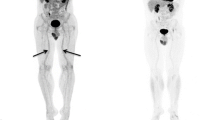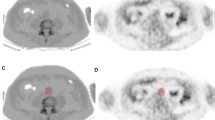Abstract
Background
The contribution of inflammation to the incidence of cardiovascular disease (CVD) has been increasingly recognized in recent years. We investigated the relationship of aortic vascular uptake of 18F-FDG by PET/CT and aortic wall thickness (AWT) by MRI in psoriasis, a chronic inflammatory disease with increased incidence of CVD. One hundred sixty-five patients with plaque psoriasis participated in an ongoing longitudinal cohort study. Subclinical atherosclerosis was assessed as aortic uptake of 18F-FDG by PET/CT reported as target-to-background ratio (TBR) and AWT by MRI reported as maximal thickness.
Results
Patients with psoriasis were middle aged, predominantly male, and had mild CV risk by traditional risk factors. Psoriasis severity as measured by PASI score was a notable determinant of AWT (ρ = 0.20, p = 0.01). Moreover, aortic vascular uptake of 18F-FDG associated with AWT by MRI at baseline in unadjusted analysis (β = 0.27 p = 0.001) and following adjustment for traditional cardiovascular risk factors, waist-to-hip ratio, and statin use (β = 0.21 p = 0.01). Finally, following 1 year of psoriasis treatment, a decrease in aortic vascular uptake of 18F-FDG was associated with a reduction in AWT in fully adjusted models (β = 0.33, p = 0.02).
Conclusion
In conclusion, we demonstrate that psoriasis severity and aortic vascular uptake of 18F-FDG in the aorta were associated with AWT. Following treatment of psoriasis, a decrease in aortic vascular uptake of 18F-FDG was associated with a reduction in AWT at 1 year. These findings suggest that aortic vascular uptake of 18F-FDG is associated with early evidence of vascular disease assessed by aortic wall thickness. Prospective studies in larger populations including other inflammatory diseases are warranted.

Similar content being viewed by others
Abbreviations
- AWT:
-
Aortic wall thickness
- MRI:
-
Magnetic resonance imaging
- 18FDG PET/CT:
-
18Fluorodeoxyglucose positron emission tomography computed tomography
- TBR:
-
Target-to-background ratio
- PASI:
-
Psoriasis area severity index
References
Ridker PM, Danielson E, Fonseca FAH, Genest J, Gotto AMJ, Kastelein JJP, et al. Rosuvastatin to prevent vascular events in men and women with elevated C-reactive protein. N Engl J Med. 2008;359(21):2195–207.
Ridker PM, Everett BM, Thuren T, MacFadyen JG, Chang WH, Ballantyne C, et al. Antiinflammatory therapy with canakinumab for atherosclerotic disease. N Engl J Med. 2017;377(12):1119–31.
Ridker PM, Rifai N, Rose L, Buring JE, Cook NR. Comparison of C-reactive protein and low-density lipoprotein cholesterol levels in the prediction of first cardiovascular events. N Engl J Med. 2002;347(20):1557–65.
Harrington RA. Targeting inflammation in coronary artery disease. N Engl J Med. 2017;377(12):1197–8.
Teague HL, Ahlman MA, Alavi A, Wagner DD, Lichtman AH, Nahrendorf M, et al. Unraveling vascular inflammation: from immunology to imaging. J Am Coll Cardiol. 2017;70(11):1403–12.
Figueroa AL, Abdelbaky A, Truong QA, Corsini E, MacNabb MH, Lavender ZR, et al. Measurement of arterial activity on routine FDG PET/CT images improves prediction of risk of future CV events. JACC Cardiovasc Imaging. 2013;6(12):1250–9.
Figueroa AL, Takx RAP, MacNabb MH, Abdelbaky A, Lavender ZR, Kaplan RS, et al. Relationship between measures of adiposity, arterial inflammation, and subsequent cardiovascular events. Circ: Cardiovasc Imaging. 2016;9(4).
Vaidya K, Arnott C, Martínez GJ, Ng B, McCormack S, Sullivan DR, et al. Colchicine therapy and plaque stabilization in patients with acute coronary syndrome: a CT coronary angiography study. JACC Cardiovasc Imaging. 2018;11(2, Part 2):305–16.
Joshi AA, Lerman JB, Dey AK, Sajja AP, Belur AD, Elnabawi YA, et al. Association between aortic vascular inflammation and coronary artery plaque characteristics in Psoriasis. JAMA Cardiol. 2018;3(10):949–56.
Dey AK, Joshi AA, Chaturvedi A, et al. Association between skin and aortic vascular inflammation in patients with psoriasis: a case-cohort study using positron emission tomography/computed tomography. JAMA Cardiol. 2017;2(9):1013–8.
Tawakol A, Fayad ZA, Mogg R, Alon A, Klimas MT, Dansky H, et al. Intensification of statin therapy results in a rapid reduction in atherosclerotic inflammation: results of a multicenter fluorodeoxyglucose-positron emission tomography/computed tomography feasibility study. J Am Coll Cardiol. 2013;62(10):909–17.
Mehta NN, Torigian DA, Gelfand JM, Saboury B, Alavi A. Quantification of atherosclerotic plaque activity and vascular inflammation using [18-f] fluorodeoxyglucose positron emission tomography (PET)/computed tomography (CT). J Vis Exp: JoVE. 2012;63:e3777-e.
Naredo E, Möller I, Corrales A, Bong DA, Cobo-Ibáñez T, Corominas H, et al. Automated radiofrequency-based US measurement of common carotid intima–media thickness in RA patients treated with synthetic vs synthetic and biologic DMARDs. Rheumatology. 2013;52(2):376–81.
Kisiel B, Kruszewski R, Juszkiewicz A, Raczkiewicz A, Bachta A, Tlustochowicz M, et al. Methotrexate, cyclosporine a, and biologics protect against atherosclerosis in rheumatoid arthritis. J Immunol Res. 2015;2015:8.
Abolmaali N, Langenfeld M, Krahforst R, Schick C, Thalhammer A, Schmitt J, et al. Vessel wall MRI of the thoracic aorta: correlation to histology and transesophageal ultrasound. Preliminary results. Rofo. 2002;174(5):568–72.
Maroules CD, Rosero E, Ayers C, Peshock RM, Khera A. Abdominal aortic atherosclerosis at MR imaging is associated with cardiovascular events: the Dallas heart study. Radiology. 2013;269(1):84–91.
Malayeri AA, Natori S, Bahrami H, Bertoni AG, Kronmal R, Lima JAC, et al. Relation of aortic wall thickness and distensibility to cardiovascular risk factors (from the multi-ethnic study of atherosclerosis [MESA]). Am J Cardiol. 2008;102(4):491–6.
Rosero EB, Peshock RM, Khera A, Clagett P, Lo H, Timaran CH. Sex, race, and age distributions of mean aortic wall thickness in a multiethnic population-based sample. J Vasc Surg. 2011;53(4):950–7.
Gupta S, Berry JD, Ayers CR, Peshock RM, Khera A, de Lemos JA, et al. Left ventricular hypertrophy, aortic wall thickness, and lifetime predicted risk of cardiovascular disease: the Dallas heart study. JACC Cardiovasc Imaging. 2010;3(6):605–13.
Liu C-Y, Chen D, Bluemke DA, Wu CO, Teixido-Tura G, Chugh A, et al. Evolution of aortic wall thickness and stiffness with atherosclerosis: long-term follow up from the multi-ethnic study of atherosclerosis (MESA). Hypertension. 2015;65(5):1015–9.
Li AE, Kamel I, Rando F, Anderson M, Kumbasar B, Lima JAC, et al. Using MRI to assess aortic wall thickness in the multiethnic study of atherosclerosis: distribution by race, sex, and age. Am J Roentgenol. 2004;182(3):593–7.
Abuabara K, Azfar RS, Shin DB, Neimann AL, Troxel AB, Gelfand JM. Cause-specific mortality in patients with severe psoriasis: a population-based cohort study in the United Kingdom. Br J Dermatol. 2010;163(3):586–92.
Mehta NN, Azfar RS, Shin DB, Neimann AL, Troxel AB, Gelfand JM. Patients with severe psoriasis are at increased risk of cardiovascular mortality: cohort study using the general practice research database. Eur Heart J. 2010;31(8):1000–6.
Naik Haley B, Natarajan B, Stansky E, Ahlman Mark A, Teague H, Salahuddin T, et al. Severity of psoriasis associates with aortic vascular inflammation detected by FDG PET/CT and neutrophil activation in a prospective observational study. Arterioscler Thromb Vasc Biol. 2015;35(12):2667–76.
Elm E, Altman DG, Egger M, Pocock SJ, Gøtzsche PC, Vandenbroucke JP. Strengthening the reporting of observational studies in epidemiology (STROBE) statement: guidelines for reporting observational studies. BMJ. 2007;335(7624):806–8.
Feldman SR, Krueger GG. Psoriasis assessment tools in clinical trials. Ann Rheum Dis. 2005;64(suppl 2):ii65–i8.
Libby P, Ridker PM, Maseri A. Inflammation and atherosclerosis. Circulation. 2002;105(9):1135–43.
Crowson CS, Liao KP, Davis JM 3rd, Solomon DH, Matteson EL, Knutson KL, et al. Rheumatoid arthritis and cardiovascular disease. Am Heart J. 2013;166(4):622–8 e1.
Rudd JH, Warburton EA, Fryer TD, Jones HA, Clark JC, Antoun N, et al. Imaging atherosclerotic plaque inflammation with [18F]-fluorodeoxyglucose positron emission tomography. Circulation. 2002;105(23):2708–11.
Yu Y, Sheth N, Krishnamoorthy P, Saboury B, Raper A, Baer A, et al. Aortic vascular inflammation in psoriasis is associated with HDL particle size and concentration: a pilot study. Am J Cardiovasc Dis. 2012;2(4):285–92.
Hayashida T, Sueyoshi E, Sakamoto I, Uetani M, Chiba K. PET features of aortic diseases. Am J Roentgenol. 2010;195(1):229–33.
Joly L, Djaballah W, Koehl G, Mandry D, Dolivet G, Marie PY, et al. Aortic inflammation, as assessed by hybrid FDG-PET/CT imaging, is associated with enhanced aortic stiffness in addition to concurrent calcification. Eur J Nucl Med Mol Imaging. 2009;36(6):979–85.
Huet P, Burg S, Le Guludec D, Hyafil F, Buvat I. Variability and uncertainty of 18F-FDG PET imaging protocols for assessing inflammation in atherosclerosis: suggestions for improvement. J Nucl Med. 2015;56(4):552–9.
Acknowledgments
We would like to acknowledge and thank NIH Clinical Center outpatient clinic-7 nurses for their invaluable contribution to the process of patient recruitment.
Availability of data and materials
The datasets used and/or analyzed during the current study are available from the corresponding author on reasonable request.
Funding
This study was supported by the National Heart, Lung and Blood Institute (NHLBI) Intramural Research Program (HL006193-05). The funding sources had no role in the design and conduct of the study; collection, management, analysis, and interpretation of the data; preparation, review, or approval of the manuscript; and decision to submit the manuscript for publication.
Author information
Authors and Affiliations
Contributions
1. Drs. Groenendyk, Dey, and Mehta had full access to all the data in the study and take responsibility for the integrity of the data and the accuracy of the data analysis.
2. Concept and design: Dr. Mehta conceived the study concept and the study design was by Drs. Mehta and Gelfand.
3. Acquisition, analysis, or interpretation of data: Drs. Groenendyk, Dey, and Mehta acquired and analyzed the data.
4. Drafting of the manuscript: Drs. Groenendyk, Dey, and Mehta drafted the manuscript.
5. Critical revision of the manuscript for important intellectual content: All co-authors provided critical revisions of the manuscript.
6. Administrative, technical, or material support: Dr. Mehta provided technical guidance to Drs. Groenendyk and Dey during the study.
Corresponding author
Ethics declarations
Ethics approval and consent to participate
The study was approved by the National Institutes of Health Institutional Review Board. From January 1, 2013, to July 1, 2018, 291 patients with psoriasis were recruited consecutively and underwent a baseline physical exam and laboratory assessment. Informed consent was obtained from each patient prior to initiation of the study.
Consent for publication
Not applicable.
Competing interests
-
1.
NNM is a full-time US government employee and has served as a consultant for Amgen, Eli Lilly, and Leo Pharma receiving grants/other payments; as a principal investigator and/or investigator for AbbVie, Celgene, Janssen Pharmaceuticals, Inc., and Novartis receiving grants and/or research funding and as a principal investigator for the National Institute of Health receiving grants and/or research funding.
-
2.
JMG was supported by an NIAMS grant (K24-AR-064310); Dr. Gelfand served as a consultant for BMS, Boehringer Ingelheim, GSK, Janssen Biologics, Menlo Therapeutics, Novartis Corp, Regeneron, Dr. Reddy’s labs, UCB (DSMB), Sanofi and Pfizer Inc., receiving honoraria; and receives research grants (to the Trustees of the University of Pennsylvania) from Abbvie, Janssen, Novartis Corp, Sanofi, Celgene, Ortho Dermatologics, and Pfizer Inc.; and received payment for continuing medical education work related to psoriasis that was supported indirectly by Lilly and Ortho Dermatologics.
-
3.
JWG is funded by the NIH Medical Research Scholars Program, a public-private partnership supported jointly by the NIH and generous contributions to the Foundation for the NIH from the Doris Duke Charitable Foundation (DDCF Grant # 2014194), Genentech, Elsevier, and other private donors.
All other authors have no conflict of interest.
Additional information
Publisher’s note
Springer Nature remains neutral with regard to jurisdictional claims in published maps and institutional affiliations.
This article is part of the Topical Collection on Cardiology
Electronic supplementary material
ESM 1
(PPTX 36 kb)
Rights and permissions
About this article
Cite this article
Groenendyk, J.W., Shukla, P., Dey, A.K. et al. Association of aortic vascular uptake of 18FDG by PET/CT and aortic wall thickness by MRI in psoriasis: a prospective observational study. Eur J Nucl Med Mol Imaging 46, 2488–2495 (2019). https://doi.org/10.1007/s00259-019-04454-w
Received:
Accepted:
Published:
Issue Date:
DOI: https://doi.org/10.1007/s00259-019-04454-w




